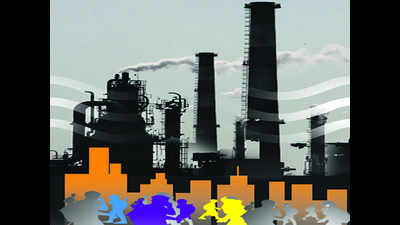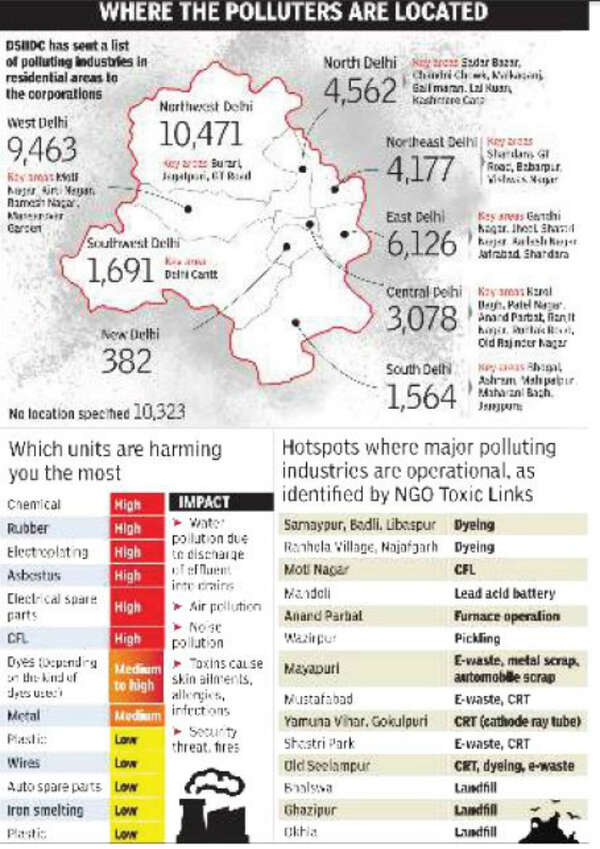- News
- City News
- delhi News
- These 51,837 factories in Delhi shouldn’t even be there
Trending
This story is from August 20, 2018
These 51,837 factories in Delhi shouldn’t even be there
Delhi’s air, already polluted by dust, industrial and vehicular emissions and soot from crop burning, is additionally assailed by these illegal industrial units that deal with dyes, chemicals, rubber, asbestos, plastics, electrical and auto spare parts, iron smelting and fluorescent lights.

Representational image
Delhi’s air, already polluted by dust, industrial and vehicular emissions and soot from crop burning, is additionally assailed by these illegal industrial units that deal with dyes, chemicals, rubber, asbestos, plastics, electrical and auto spare parts, iron smelting and fluorescent lights.
These pollute water by discharging effluent directly into drains and air by emitting noxious particles. In 1996, DSIIDC had, under the relocation scheme for industrial establishments, allotted plots to factory owners running their units from residential areas. And as far back as 2003, the Supreme Court, in its judgment in MC Mehta v Union of India, had directed that all industrial units that had come up in non-conforming areas on or after August 1, 1990 should be closed within a given timeframe. But, even in 2018, as the DSIIDC listing proves, they continue operations from residential areas.
According to Master Plan Delhi 2021, only 28 domestic small-scale industries like matchstick making, incense sticks and garland making are allowed from residential areas. Under MPD, all polluting industries are to be shifted out of Delhi by 2021.

In 2014, NGO Toxics Link identified 18 hotspots in Delhi, including Samaypur, Badli, Okhla, Ghazipur, Mayapuri, Moti Nagar, Yamuna Vihar, Gokulpuri, Shastri Park and Wazirpur. The report cited Central Pollution Control Board’s data for 2010 showing Delhi among the cities with the most polluted air. “In 1975, vehicular population in Delhi and Mumbai was same. But by 1997, Delhi had three times more vehicles than Mumbai. Vehicular pollution contributed 6% of the total air pollution load in Delhi. Another 25% was generated by industries and coal-based thermal power plants,” the report stated.
The municipal corporations have only listed 32,541 illegal factories in areas under their jurisdiction — 11,805 under the East Delhi Municipal Corporation, 11,214 under the north body, and 10,023 in the south. EDMC has so far verified 2,251 units, and reported that 1,145 of these were found to have shut down. “The survey is going on, and we have issued notices to the industries that we have inspected so far,” said an EDMC official. The north civic body, in its survey, found 9,522 units operating from residential areas, while 874 it had listed were found vacant and 818 were sealed.
Many of the listed units are either locked or closed, said SDMC officials. “We have directed the zonal officials to find out whether the industries deemed to be operating illegally were still running or had shut down. Those still found operating will be sealed for failure to relocate as required by the Delhi Municipal Corporation Act,” said an SDMC official.
Sources in the civic bodies disclosed that these industries are illegal not only because they run from unauthorised areas, but also because they do not have the licence to operate. “It is totally up to the enforcement agencies to keep track of the polluting factories operating from residential areas,” a source declared. Despite several orders of Delhi HC and DSIIDC, the corporations have failed to take action. On July 9, hearing the Bawana Factory Welfare Association vs Govt of NCT & Others case, an HC bench expressed unhappiness “on the tardy action on this issue by the corporations”.
End of Article
FOLLOW US ON SOCIAL MEDIA
Visual Stories
Hot Picks
TOP TRENDING
Explore Every Corner
Across The Globe










